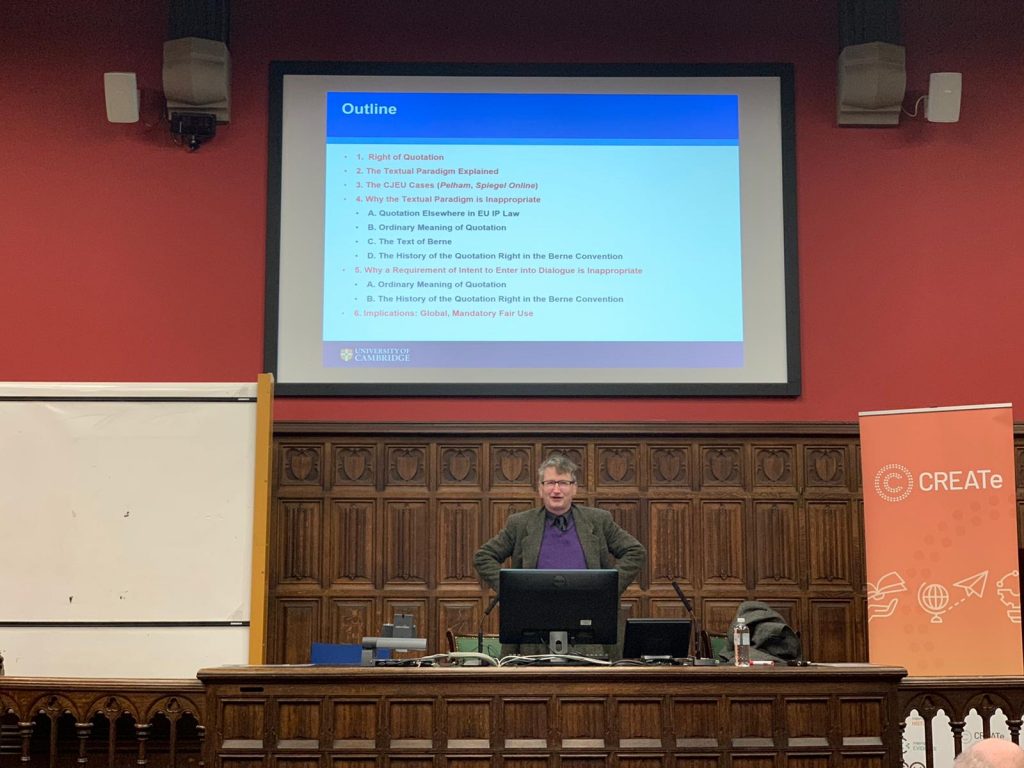
This report is being published together with the related CREATe Working Paper 2020/8 – Copyright and Quotation in Film and TV – by Professor Lionel Bently. The paper Copyright and Quotation in Film and TV is an edited transcript of the keynote delivered by Bently at Learning on Screen Members’ Day: Copyright and Creative Reuse, 8th December 2018, RSA House, London, and updated to reflect changes in the law as of 24 April 2020. You can access the paper here.
On 12th February 2020, I had the pleasure to attend the excellent CREATe Public Lecture Copyright and Quotation: Beyond the Textual Paradigm by Professor Lionel Bently (University of Cambridge). I was particularly interested in this lecture as I am currently conducting a research project aimed exploring the role that creative and cultural practice can play in defining legal standards such as fairness, using the quotation exception as a lens of investigation.
The Berne Convention requires its 188 participants to recognise the quotation right. Article 10(1) states:
‘It shall be permissible to make quotations from a work which has already been lawfully made available to the public, provided that their making is compatible with fair practice, and their extent does not exceed that justified by the purpose, including quotations from newspaper articles and periodicals in the form of press summaries.’
By stating that quotation ‘shall be permissible’, the international copyright system creates an obligation on Members of the Union to enact a quotation exception that should not be subjected to additional conditions beyond those recognised in Article 10. In other words, the quotation exception should not be limited by work, nor by type of act, nor by purpose. The language of the InfoSoc Directive 2001/29/EC and that of the UK Copyright, Designs and Patents Act 1988 reflects the open-ended nature of the quotation exception: art. 5(3) of the Directive lists ‘quotation for purposes such as criticism or review’ among the exceptions that Member States may implement; Section 30(1ZA) CDPA allows ‘the use of a quotation from the work (whether for criticism or review or otherwise)’.
The central point of Bently’s public lecture was that in order to properly understand the scope of the quotation right, we need to abandon the textual paradigm that traditionally defines quotation through conventions such as that the quoted passage must be unaltered, presented as distinct and deployed to further an argument. The quotation exception applies to all works covered by the Berne Convention (‘literary and artistic works’, a broad definition which includes visual art, music, dramatic works, and films, among others). Rather than elevating conventions associated to literary quotation into limitations to the quotation right, we should try to understand how the term ‘quotation’ is ordinarily used across all cultural forms.
Nevertheless, the Court of Justice of the European Union (CJEU), in their recent judgements in Pelham and Spiegel Online, have adopted once again the textual paradigm to interpret the quotation exception. In Spiegel Online, the CJEU, following the opinion of AG Szpunar, stated that in order to rely on the quotation exception, the user must ‘necessarily establish a direct and close link between the quoted work and his own reflections, thereby allowing for an intellectual comparison to be made with the work of another’. In Pelham, the Court listed as ‘essential characteristics of a quotation’ ‘the use […] of a work […] for the purposes of illustrating an assertion, of defending an opinion or of allowing an intellectual comparison between that work and the assertions of that user‘, and ‘the intention of entering into “dialogue” with that work’.
Bently was particularly critical of the latter ‘dialogic’ requirement and challenged the CJEU reasoning with three main lines of arguments. First, these judgements are not consistent with how the court interpreted the notion of quotation elsewhere in IP law. For example, in Nintendo v BigBen Interactive – interpreting Art. 20(1)(c) of Regulation No 6/2002 on Community designs (acts of reproduction for the purpose of making citations) – the CJEU recognised the need for a broader notion of quotation by stating that citations of protected designs are acceptable also ‘in order to explain or demonstrate the joint use of [..] two categories of products’.
Second, Bently stressed how ‘quotation’ should reflect the usual meaning of the word in everyday language, as explicitly stated by the CJEU in Pelham and Spiegel Online. By showing famous works of architecture characterised by experts as examples of quotation – such as Philip Johnson’s 550 Madison Avenue – Bently noted how architecture commentators use the term quotation to describe the reuse of particular forms, which does not have any of the attributes of the textual paradigm. He furthered this argument by showing how even ‘dictionaries of quotations’ such as Why do we quote? The culture and history of quotation (Ruth H. Finnegan, 2011) do not follow the textual paradigm to define the notion of quotation.

The third and probably most persuasive argument was based on the history of the Berne Convention. At the Rome Revision in 1928 and the Stockholm Conference in 1967, there were proposals to limit article 10(1) to unaltered and short textual quotations, and ‘to the extent that they serve as an explanation, reference or illustration in the context in which they are used’. These proposals were explicitly rejected.
Based on these observations, Bently concludes that the key limitation to the quotation right is ‘fairness’. The Berne Convention recognises global, mandatory, fair use: ‘global’ because it derives from international copyright law; ‘mandatory’ because article 10(1) explicitly states that quotation ‘shall be permissible’; ‘fair’ because quotation must be ‘compatible with fair practice’; and ‘use’ because quoting an existing work amounts to using it.
This fascinating thesis is further developed in the upcoming book Global Mandatory Fair Use by Professors Lionel Bently and Tanya Aplin (King’s College London). I look forward to reading Bently’s and Aplin’s analysis of fairness in their upcoming book, and I hope my research on creative reuse of audiovisual works will contribute to capturing current ‘fair practice’.
Copyright and Quotation in Film and TV by Prof. Lionel Bently
Abstract
This paper explores the application of the exception permitting quotation, first introduced into UK law in 2014, to film and television. It seeks to demonstrate that the concept of quotation is broad and thus that this exception offers much-needed flexibility to film-makers to utilise copyright-protected material without obtaining permission to do so. The paper explains some of the key limitations on the availability of the defence, in particular, the requirement of fair dealing (or use in accordance with fair practice) and sufficient acknowledgment (attribution). The significance of the exception is examined through three examples: Love is the Devil, Titanic and the art piece The Clock.
Full paper can be downloaded here.



